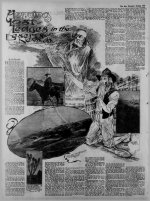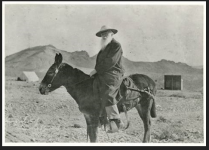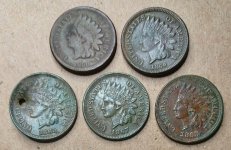Old Bookaroo
Silver Member
- Dec 4, 2008
- 4,318
- 3,510
HUNTING LOST LEDGES IN THE DESERTS OF NEVADA.
By Del Reynolds
By Del Reynolds
NEVADA has been a land of mystery, a land of countless tragedies and of little law; a land in which there are truths that are stranger than any fiction and in which stories of riches, found only to be lost again, are on every lip; for even the coming of the railroad and of the automobile has served to open only in a very small degree the sealed book of her deserts. Since the days of the Comstock the plains of Nevada have been assailed by forlorn hopes, by fortune hunters, by adventurers, and those dreamers to whom the pot of gold at the end of the rainbow always seems within reach.
These are the men who have found, only to lose again, the fabled Breyfogle, Pegleg and Lost Bethune, and in a hundred bunkhouses and around a hundred prospectors' grease root fires the stories of lost mines are told and re-told, their wealth growing with each repetition, while in every instance the speaker gives the impression that someday, some place, he will be the man who will work out the problem of the hidden Golconda.
A month ago, on the western slope of the Funeral Range, where the mountains drop sternly down into Death Valley, I sat in a bunkhouse and heard the story of the Pegleg from an old prospector who had tramped the Nevada hills for twenty years, searching for the highest of the three peaks, where lies the sunburned placer such that is to make him rich beyond his dreams.
The tale was told slowly, while the smoke from a long prospector's pipe curled upward and the men in the bunks around the wall dropped their arguments and their week-old papers to listen, for there Is not a miner in the Nevada hills who is not interested in the story of the lost ledges.
"There's a curse on the Pegleg. It has been found four times in seventy five years and never yet has a man lived to enjoy his gold or to tell another where it came from. I know and every other desert rat knows where the mine is to within a radius of 100 miles, but though hundreds of us have prospected the country we have never found anything better than a God-forsaken desert and the bones of men who have tried the trail before.
"The Pegleg is not far from the turn in Warner's Pass on the old Yuma-Los Angeles trail and anybody that wants the direction can have it for all of me. It was twenty years ago when I heard the story of the Pegleg. They told us there were three peaks in a line and that the middle one contained the gold. We went over the ground and found hundreds of peaks in line, but never a bit of gold. Other fellows that I know have been over the ground and I suppose that some day some one will stumble across that gully with its sunburned gold. When he finds it city people will say that he is a lucky dog, but they will never think of the lives we prospectors I have spent in searching for that gold and for the lives it has already cost to find it.
"There’s truth in the Pegleg tale, for specimens of the gold are in the museums where any one can see them, and once seen there is no question about it, for they are like no other gold that was ever found.
The Pegleg was named for Pegleg Smith, a frontier gentleman with one wooden prop, who tried to take a cut-off from Yuma to Los Angeles on the Warner Pass trail about seventy-five years ago. He naturally lost his way' and nearly died of thirst, but picked up some curious nuggets. It was a year before he found out their real value. When he learned how near he had come to being a rich man, he took brain fever in Los Angeles. There wasn't much that the booze had left the fever to I work on, but anyway he died without having had the chance to get back into the Warner Pass country.
Within two days from the time Smith’s find became known, more than fifty outfits had left Los Angeles. Most of the men died of heat and thirst, a few were crazed and the rest drifted back to Los Angeles, broken in mind and body.
“It was fifteen years after that when a miner drifted into Los Angeles with another load of the Pegleg gold. He had $7000 worth of the sunburned nuggets tied in the corner of an old blanket, but he died within a week from the desert hardships and privations and he took his secret with him to the grave.
"For years the story of the Pegleg gold ran the rounds of the Western country; then it began to die out and not until1891was the Pegleg gold seen again. One day in August an Indian squaw stumbled into a Southern Pacific construction camp, on the edge of the Salton sink, half dead from thirst, with ten pounds of the Pegleg gold wrapped in her skirt. She and her man had been lost in the desert, had climbed the central of three peaks to get their bearings and had run into the Pegleg placer.
She said she had seen the smoke of the camp from where she found the gold, but refused to lead any of the workmen to it. Her man died that night, and in the morning the squaw sold the gold to the section boss and vanished into the desert from which she had come.
"In 1896 I went into San Bernardino to rustle a grubstake and dropped into a low-ceiled Mexican saloon. It was August and hot and the barkeeper was nodding on his stool in the corner behind the bar when a Mexican vaquero swung off a pinto, tossed the bridle over the horse's head and came into the room, spurs clanking and his chaps whistling like corduroys.
"He walked up to the bar, hauled out a buckskin sack from inside his shirt, picked out a sunburned nugget, slammed it on the bar and waved everybody up for a drink.
“That nugget was of the Pegleg gold.
“For a month, San Bernardino was back in the old Spanish ways of the gold excitement and the Pegleg vaquero paid the piper.
"He drank, gambled and threw away his nuggets as though he owned the United States Mint. Then one day he vanished as quickly as he had come.
''He was gone three weeks and when he came back he had another load of the gold. Twice after that he went into the desert and each time he was followed by ambitious trailers but without avail.
“The end came suddenly at a Mexican Saturday night fiesta. There was a dance in a saloon, and the Pegleg vaquero was the center of attraction as far as the girls were concerned. Guitars were tinkling and castanets clicking and Dago red and mescal had done their work. “Pegleg” tried to take a girl away from another vaquero. There was the whistle of a knife thrown across the room and it struck quivering in his shoulder. He reached for his gun and a dozen knives went into him before he could draw it.
“He was dead when the police came, with $7OOO on deposit at the “Home” ranch but not a cent in his clothes. The Mexicans had seen to that.
“He carried his secret with him, for no papers or maps were found, and his money was divided among the men who been riding the range with him before he struck the placer.
"That's all any one knows of the Pegleg, but there are dozens of men in the Mojave that are looking for it and when it is found there will be another millionaire in the world— if he succeeds in getting out with his nuggets and can find his way back to the placer, again.
No less Interesting than the tale of the Pegleg is the story of the Lost Breyfogle, which is somewhere within a radius of 100 miles of the present site of Rhyolite.
John McDonald, miner, prospector and old-timer on the desert, former Montana cattle king, broker. Sheriff of the old Nevada school, and, when necessary, one of the coolest gun fighters in the West, is the authority for the Breyfogle data.
According to McDonald's story, Breyfogle went into the Nevada deserts from Los Angeles some thirty years ago. He stayed on the desert for almost a year, prospecting, and three days before his great discovery was camping not far from the present Johnnie mining camp. Running short of water his burros left camp in search for it on their own account. Breyfogle followed their trail on foot through what is now the Johnnie Pass in the Charleston Mountains, and to the left of the pass came upon Grapevine Springs. Near the springs be found a rich ledge from which he took away about three quarters of a ton of ore. This he packed overland to Salt Lake, and from its sale netted $55,000.
The ore was the richest that had ever been taken to the Salt Lake smelters, for it ran nearly $80,000 to the ton.
Lived Life of a Millionaire
For more than a year Breyfogle refused to show the road to any one, but lived high, drank, gambled and made love from New York to San Francisco.
Running short of ready money , he disappeared into the " desert, from the neighborhood of Reno, was gone four months and returned with $37,000 worth of ore.
A year later he was induced to pilot an expedition headed by a man named Finlay into the desert country to find his mine, but instead of making the point of departure Reno the party elected to enter the desert from Yuma on the south.
Camps were made at Stump Springs, at Manse and a Pahrump. It was at this place that Breyfogle attempted to get is bearings.
At the time of the original discovery he had gone to Pahrump and had noticed from there that his mine lay near the clump of trees at Grapevine Springs, and was marked by the low Johnnie Pass through the mountains.
Coming in from the south, Six Mile Pass with Six Mile Springs, the same distance from Pahrump as is Johnnie Pass, came into view, and as the topography of the country is similar, Breyfogle led Finley and his party to the wrong pass and the wrong springs. Search for the Breyfogle ledge was, of course, unavailing, and before the mistake was discovered Breyfogle was tomahawked by an Indian named Scott at Stump Springs.
Scott knew the location of the mine and killed Breyfogle to preserve the secret. His daughter, a squaw now on the Johnnie reservation, knows its location, but even when drunk refuses to lead prospectors to it.
The old Chester mine, which showed rich on the surface but which worked out at a depth of nineteen feet, probably was Breyfogle's lost ledge.
After Breyfogle's death, Finley continued the search and located several now great mines of Lee Echo district.
The country was not then open, however, and nothing was done in the development line until within the last two years, when the coming of the railroad opened the country.
The story of the Lost Bethune is another desert romance. Colonel Bethune, prospector and miner, found, some ten years ago, near Ibex Springs, the remains of an old lead and silver mine which had been worked hundreds of years before. Stone arrowheads, hatchets and cooking pots were buried in the sand, while by the side of a long-dead spring were the remains of the dwellings of a departed people, who were not Indians of the present desert type. In the Bethune mine were workings hundreds of feet deep, and every evidence of extensive mining, although it was evident that no work had ever been done by means of blasting powder or drills.
Bethune monumented the property but because of the difficulty of transportation did nothing with it. Specimens were carried to San Francisco, Salt Lake and Los Angeles, and when the first news reached the coast of the proposed building of the Salt Lake road a rush was made into the country of the Bethune.
One day on the Death Valley slope of the Funeral range a prospector found a single monument, and beside it the skeleton of a man— Bethune— and in the monument was a *scrap of paper which told a story of lost burros and an exhausted water supply.
A search for the Bethune mine began at once, but it was not until two years later that its whereabouts was discovered by Charles Cushman, who relocated and now operates the mine.
The San Francisco Call, 7 April 1907 (Magazine Section – Part I)
Good luck to all,
The Old Bookaroo
Last edited:








